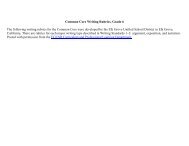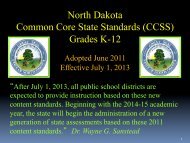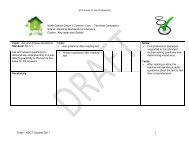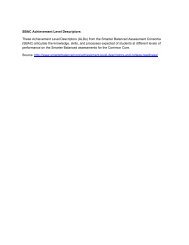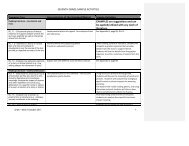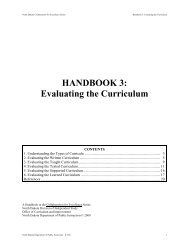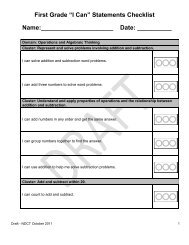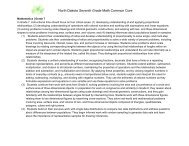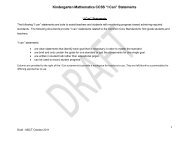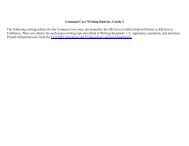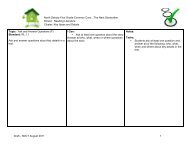A. ND Mathematics Content Standards, Grade 5 - ND Curriculum ...
A. ND Mathematics Content Standards, Grade 5 - ND Curriculum ...
A. ND Mathematics Content Standards, Grade 5 - ND Curriculum ...
Create successful ePaper yourself
Turn your PDF publications into a flip-book with our unique Google optimized e-Paper software.
Domain: Operations and Algebraic Thinking<br />
Cluster: Write and interpret numerical expressions.<br />
Code <strong>Standards</strong> Annotation<br />
5.OA.1 Use parentheses, brackets, or braces in numerical expressions, and evaluate<br />
expressions with these symbols.<br />
5.OA<br />
5.OA.2<br />
Write simple expressions that record calculations with numbers, and interpret<br />
numerical expressions without evaluating them. For example, express the<br />
calculation “add 8 and 7, then multiply by 2” as 2 × (8 + 7). Recognize that 3 ×<br />
(18932 + 921) is three times as large as 18932 + 921, without having to calculate<br />
the indicated sum or product.<br />
Cluster: Analyze patterns and relationships.<br />
Code <strong>Standards</strong> Annotation<br />
5.OA.3<br />
Generate two numerical patterns using two given rules. Identify apparent<br />
relationships between corresponding terms. Form ordered pairs consisting of<br />
corresponding terms from the two patterns, and graph the ordered pairs on a<br />
coordinate plane. For example, given the rule “Add 3” and the starting number 0,<br />
and given the rule “Add 6” and the starting number 0, generate terms in the<br />
resulting sequences, and observe that the terms in one sequence are twice the<br />
corresponding terms in the other sequence. Explain informally why this is so.<br />
This standard includes the following skills:<br />
a. Generate two numerical patterns using two given rules.<br />
b. Identify the relationship between the two patterns.<br />
c. Form ordered pairs for each pattern.<br />
d. Graph the ordered pairs on a coordinate plane.<br />
e. Use graph to verify the relationship. (<strong>ND</strong>)<br />
Domain: Number and Operations in Base Ten<br />
Cluster: Understand the place value system.<br />
Code <strong>Standards</strong> Annotation<br />
5.NBT.1<br />
Recognize that in a multi-digit number, a digit in one place represents 10 times as<br />
much as it represents in the place to its right and 1/10 of what it represents in the<br />
place to its left.<br />
5.NBT<br />
5.NBT.2<br />
5.NBT.3<br />
Explain patterns in the number of zeros of the product when multiplying a number<br />
by powers of 10, and explain patterns in the placement of the decimal point when a<br />
decimal is multiplied or divided by a power of 10. Use whole-number exponents to<br />
denote powers of 10.ecimal is multiplied or divided by a power of 10. Use<br />
whole-number exponents to denote powers of 10.<br />
Read, write, and compare decimals to thousandths.<br />
a. Read and write decimals to thousandths using base-ten numerals, number<br />
names, and expanded form, e.g., 347.392 = 3 × 100 + 4 ×10 + 7 × 1 + 3 ×<br />
(1/10) + 9 × (1/100) + 2 × (1/1000).<br />
b. Compare two decimals to thousandths based on meanings of the digits in<br />
North Dakota <strong>Mathematics</strong> <strong>Content</strong> <strong>Standards</strong><br />
Based on the Common Core State <strong>Standards</strong><br />
<strong>Grade</strong> 5 11 June 2011



